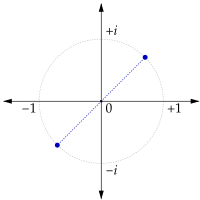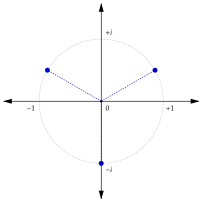Imaginary unit

The imaginary unit or unit imaginary number (i) is a solution to the quadratic equation x2 + 1 = 0. Although there is no real number with this property, i can be used to extend the real numbers to what are called complex numbers, using addition and multiplication. A simple example of the use of i in a complex number is 2 + 3i.
Imaginary numbers are an important mathematical concept; they extend the real number system to the complex number system in which at least one
There are two complex square roots of −1: i and −i, just as there are two complex
In contexts in which use of the letter i is ambiguous or problematic, the letter j is sometimes used instead. For example, in
Terminology
Square roots of negative numbers are called imaginary because in
A unit is an undivided whole, and unity or the unit number is the number one (1).
Definition
| The powers of i are cyclic: |
|---|
The imaginary unit i is defined solely by the property that its square is −1:
With i defined this way, it follows directly from algebra that i and −i are both square roots of −1.
Although the construction is called "imaginary", and although the concept of an imaginary number may be intuitively more difficult to grasp than that of a real number, the construction is valid from a mathematical standpoint. Real number operations can be extended to imaginary and complex numbers, by treating i as an unknown quantity while manipulating an expression (and using the definition to replace any occurrence of i2 with −1). Higher integral powers of i are thus
As a complex number, i can be represented in
i vs. −i
Being a
The only differences between +i and −i arise from this labelling. For example, by convention +i is said to have an argument of and −i is said to have an argument of related to the convention of labelling orientations in the
A more formal expression of this indistinguishability of +i and −i is that, although the complex
Matrices
Using the concepts of matrices and matrix multiplication, complex numbers can be represented in linear algebra. The real unit 1 and imaginary unit i can be represented by any pair of matrices I and J satisfying I2 = I, IJ = JI = J, and J2 = −I. Then a complex number a + bi can be represented by the matrix aI + bJ, and all of the ordinary rules of complex arithmetic can be derived from the rules of matrix arithmetic.
The most common choice is to represent 1 and i by the 2 × 2 identity matrix I and the matrix J,
Then an arbitrary complex number a + bi can be represented by:
More generally, any real-valued 2 × 2 matrix with a
Root of x2 + 1
Polynomials (weighted sums of the powers of a variable) are a basic tool in algebra. Polynomials whose coefficients are real numbers form a ring, denoted an algebraic structure with addition and multiplication and sharing many properties with the ring of integers.
The polynomial has no real-number
Graphic representation
The complex numbers can be represented graphically by drawing the real number line as the horizontal axis and the imaginary numbers as the vertical axis of a Cartesian plane called the complex plane. In this representation, the numbers 1 and i are at the same distance from 0, with a right angle between them. Addition by a complex number corresponds to translation in the plane, while multiplication by a unit-magnitude complex number corresponds to rotation about the origin. Every similarity transformation of the plane can be represented by a complex-linear function
Geometric algebra
In the geometric algebra of the Euclidean plane, the geometric product or quotient of two arbitrary vectors is a sum of a scalar (real number) part and a bivector part. (A scalar is a quantity with no orientation, a vector is a quantity oriented like a line, and a bivector is a quantity oriented like a plane.) The square of any vector is a positive scalar, representing its length squared, while the square of any bivector is a negative scalar.
The quotient of a vector with itself is the scalar 1 = u/u, and when multiplied by any vector leaves it unchanged (the
More generally, in the geometric algebra of any higher-dimensional Euclidean space, a unit bivector of any arbitrary planar orientation squares to −1, so can be taken to represent the imaginary unit i.
Proper use
The imaginary unit was historically written and still is in some modern works. However, great care needs to be taken when manipulating formulas involving radicals. The radical sign notation is reserved either for the principal square root function, which is defined for only real x ≥ 0, or for the principal branch of the complex square root function. Attempting to apply the calculation rules of the principal (real) square root function to manipulate the principal branch of the complex square root function can produce false results:[7]
Generally, the calculation rules and are guaranteed to be valid for real, positive values of x and y only.[8][9][10]
When x or y is real but negative, these problems can be avoided by writing and manipulating expressions like , rather than . For a more thorough discussion, see square root and branch point.
Properties
As a complex number, the imaginary unit follows all of the rules of complex arithmetic.
Imaginary integers and imaginary numbers
When the imaginary unit is repeatedly added or subtracted, the result is some integer times the imaginary unit, an imaginary integer; any such numbers can be added and the result is also an imaginary integer:
Thus, the imaginary unit is the generator of a group under addition, specifically an infinite cyclic group.
The imaginary unit can also be multiplied by any arbitrary real number to form an imaginary number. These numbers can be pictured on a number line, the imaginary axis, which as part of the complex plane is typically drawn with a vertical orientation, perpendicular to the real axis which is drawn horizontally.
Gaussian integers
Integer sums of the real unit 1 and the imaginary unit i form a
Quarter-turn rotation
When multiplied by the imaginary unit i, any arbitrary complex number in the complex plane is rotated by a quarter turn ( radians or 90°)
In rectangular form,
Integer powers
The powers of i repeat in a cycle expressible with the following pattern, where n is any integer:
Thus, under multiplication, i is a generator of a cyclic group of order 4, a discrete subgroup of the continuous circle group of the unit complex numbers under multiplication.
Written as a special case of Euler's formula for an integer n,
With a careful choice of
Roots

Just like all nonzero complex numbers, has two distinct square roots which are additive inverses. In polar form, they are
In rectangular form, they are[a]
Squaring either expression yields

The three cube roots of i are[12]
For a general positive integer n, the n-th roots of i are, for k = 0, 1, ..., n − 1,
Exponential and logarithm
The
The complex exponential can be broken into even and odd components, the hyperbolic functions cosh and sinh or the trigonometric functions cos and sin:
Euler's formula decomposes the exponential of an imaginary number representing a rotation:
The quotient coth z = cosh z / sinh z, with appropriate scaling, can be represented as an infinite
Other functions based on the complex exponential are well-defined with imaginary inputs. For example, a number raised to the ni power is:
Because the exponential is periodic, its inverse the
For example, if one chooses any branch where then when x is a positive real number,
Factorial
The factorial of the imaginary unit i is most often given in terms of the gamma function evaluated at 1 + i:[15]
The magnitude and argument of this number are:[16]
See also
- Hyperbolic unit
- Right versorin quaternions
Notes
- ^ To find such a number, one can solve the equation (x + iy)2 = i where x and y are real parameters to be determined, or equivalently x2 + 2ixy - y2 = i. Because the real and imaginary parts are always separate, we regroup the terms, x2 - y2 + 2ixy = 0 + i. By equating coefficients, separating the real part and imaginary part, we have a system of two equations:
Substituting into the first equation, we get Because x is a real number, this equation has two real solutions for xand . Substituting either of these results into the equation 2xy = 1 in turn, we will get the corresponding result for y. Thus, the square roots of i are the numbers and .[11]
References
- ISBN 0-471-19826-9.
- .
- ^ "imaginary number". Oxford English Dictionary (Online ed.). Oxford University Press. (Subscription or participating institution membership required.)
- ISBN 978-0-471-54397-8.
- ISBN 978-0-691-14904-2– via Google Books.
- .
- ISBN 978-0-486-13793-3– via Google Books.
- ISBN 978-1-133-70753-0– via Google Books.
- ISBN 978-1-56107-252-1– via Google Books.
- ISBN 978-1-4008-3029-9– via Google Books.
- ^ "What is the square root of i ?". University of Toronto Mathematics Network. Retrieved 26 March 2007.
- OCLC 50495529.
- ^ Euler expressed the partial fraction decomposition of the trigonometric cotangent as Varadarajan, V. S. (2007). "Euler and his Work on Infinite Series". Bulletin of the American Mathematical Society. New Series. 44 (4): 515–539. .
- ISBN 978-0-511-91510-9.
- S2CID 24405635. Sloane, N. J. A. (ed.). "Decimal expansion of the real part of i!", Sequence A212877; and "Decimal expansion of the negated imaginary part of i!", Sequence A212878. The On-Line Encyclopedia of Integer Sequences. OEIS Foundation.
- ^ Sloane, N. J. A. (ed.). "Decimal expansion of the absolute value of i!", Sequence A212879; and "Decimal expansion of the negated argument of i!", Sequence A212880. The On-Line Encyclopedia of Integer Sequences. OEIS Foundation.
Further reading
- Nahin, Paul J. (1998). An Imaginary Tale: The story of i [the square root of minus one]. Chichester: Princeton University Press. ISBN 0-691-02795-1– via Archive.org.
External links
- Euler, Leonhard. "Imaginary Roots of Polynomials". at "Convergence". mathdl.maa.org. Mathematical Association of America. Archived from the original on 13 July 2007.

















![{\displaystyle {\begin{alignedat}{3}i^{3}&=i^{2}i&&=(-1)i&&=-i,\\[3mu]i^{4}&=i^{3}i&&=\;\!(-i)i&&=\ \,1,\\[3mu]i^{5}&=i^{4}i&&=\ \,(1)i&&=\ \ i,\end{alignedat}}}](https://wikimedia.org/api/rest_v1/media/math/render/svg/381aa96747a694603793737c7038a20b314534e9)






![{\displaystyle \mathbb {R} [x],}](https://wikimedia.org/api/rest_v1/media/math/render/svg/8a990f60289eb6d302674d3d54b8e52f1c9955ad)

![{\displaystyle \mathbb {R} [x]/\langle x^{2}+1\rangle .}](https://wikimedia.org/api/rest_v1/media/math/render/svg/c90eaee192547028462852200009bcb20cf10261)










(c+di)&=(ac-bd)+(ad+bc)i.\end{aligned}}}](https://wikimedia.org/api/rest_v1/media/math/render/svg/a410e1941798b67ee103d73e09a01fe5f61747ec)







![{\displaystyle {\begin{alignedat}{3}{\sqrt {i}}&=\ (1+i){\big /}{\sqrt {2}}&&{}={\phantom {-}}{\tfrac {\sqrt {2}}{2}}+{\tfrac {\sqrt {2}}{2}}i,\\[5mu]-{\sqrt {i}}&=-(1+i){\big /}{\sqrt {2}}&&{}=-{\tfrac {\sqrt {2}}{2}}-{\tfrac {\sqrt {2}}{2}}i.\end{alignedat}}}](https://wikimedia.org/api/rest_v1/media/math/render/svg/fa96e19d51311f921778c806f7d04abf7acfb3df)

![{\displaystyle {\sqrt[{3}]{i}}={\exp }{\bigl (}{\tfrac {1}{6}}\pi i{\bigr )}={\tfrac {\sqrt {3}}{2}}+{\tfrac {1}{2}}i,\quad {\exp }{\bigl (}{\tfrac {5}{6}}\pi i{\bigr )}=-{\tfrac {\sqrt {3}}{2}}+{\tfrac {1}{2}}i,\quad {\exp }{\bigl (}{-{\tfrac {1}{2}}\pi i}{\bigr )}=-i.}](https://wikimedia.org/api/rest_v1/media/math/render/svg/58cf1d15d64e94e75230463ad097ffa5cf35a490)









![{\displaystyle {\begin{aligned}x^{2}-y^{2}&=0\\[3mu]2xy&=1.\end{aligned}}}](https://wikimedia.org/api/rest_v1/media/math/render/svg/920fdcc901545bfaa91d0654462007376c1b732b)







